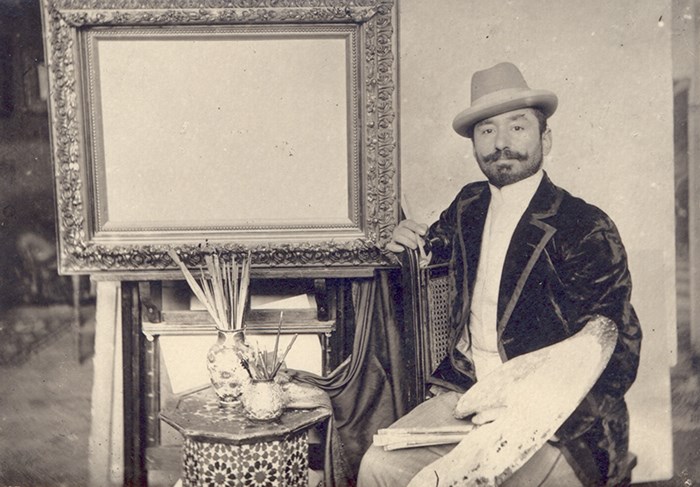
Vardges Hakobi Surenyants
1860 - 1921
1890 - 1900s
Aforebear of realism and the ‘modern’ style in Armenian painting, Vardges Surenyants was one of the first Armenian artists to make use of the photo camera in his creative practice. Man of his large-scale historically-themed canvases were based on detailed architectural, archival and archaeological research in which the photograph played a crucial role as both a means of documentation and a form of pre-visualisation.
Born in the Armenian-populated city of Akhaltskha (currently in Georgia), Surenyants had received his professional training in Moscow and later, at the Munich Academy of Art. After graduating in 1885, the artist constantly moved about the Russian Empire, working in Moscow, St. Petersburg, Ejmiatsin, Tiflis, Yalta and, briefly, in Iran. He was a pioneering figure modern Armenian culture who worked in almost every genre of visual arts – from painting and illustration to stage and architectural design. At the same time, Surenyants also produced a number of important literary translations into Armenian, while making a serious contribution to the history of Armenian art with a series of critical essays.(1) His work with photography, however, has been sidelined in the debates and studies surrounding the artist’s oeuvre.
It is not clear what prompted Surenyants to use the camera. As with many European artists who used the medium (Gerome, for example) as a visual source for their artworks, photography allowed Surenyants to quickly collate ‘research notes’ for large-scale thematic paintings that required the indexical precision of photographs. Surenyants went further, however. By making his own photographs, he could ‘test’ the complete idea of the laboriously painted canvases before putting down a single brushwork. Thus, nearly all of the photographs taken by the artist were staged as preparational studies for future paintings and illustrations. These were not fragments or raw source material, but fully choreographed and costumed scenes that often ended up in Surenyants’ drawings and paintings without significant alterations.
Though performed, these preparatory photo-sketches rely greatly on the documentary qualities of photography. Here, Surenyants did not aim to create a ‘painterly’ illusion as in the works of Gustav Le Gray or Julia Margaret Cameron. Rather the artist wanted to transfer the mimetic veracity of the photograph onto his often hyper-realistic canvases. This ‘photographism’ was so pervasive that Surenyants himself saw it as a detrimental aspect of his art. And yet, the cinematic pulse which brims through his illustrations for Alexander Pushkin’s ‘The Bakhchisaray Fountain’ (1899) and other similar works, is due precisely to this illusionistic quality. Indeed, while looking at the photographic studies the artist made for ‘Bakhchisaray’, one could easily mistake them for stills from a silent film.
In tandem with his significant collection of archaeological material, photography served Surenyants as a means for engendering a scientifically convincing image of Armenia’s historical identity. This was part of a larger ‘restorative’ turn in Armenian intellectual production of the late 19th century, that aspired to distance itself from ecclesiastical representational systems by perpetuating a critical view of current reality and the nation’s past. Archaeology, history, photography and painting were thus intertwined in a cycle of mutual influence. Interestingly, Surenyants photographically recreated scenes that were mostly drawn from the Bible, Armenian fairytales, mythology and folklore. In icon paintings executed for various Armenian churches, Surenyants’ religious figures look like recognizable, ordinary-looking people who were based on photographs of artist’s family members or models discovered on the streets. These works continue to move and fascinate the viewer because of this humanist appeal and claims to authenticity which comes from the meticulous specificity of ethnographic and architectural detail. Surenyants’ albumen photographs themselves are composed with this aesthetic impact already in mind.
While he never thought of his photography as anything other than a technological aid, Surenyants was clearly aware of the medium’s potential to be much more than a documentary or mimetic record of reality. His photographs reveal not only the complexity of his creative process but also the extent of photography’s diverse uses in Armenian art and culture at the turn of the 20th century.
1) For a more detailed biographical account see Vahan Harutyunyan, Vardges Surenyants [in Armenian], Yerevan, 1960
Nationality
Armenian, Russian
Region
Armenia, Russian Empire, Russia
City
Akhaltskha, Ejmiatsin, Moscow, St. Petersburg, Yalta, Munich
Activity
art historian, artistic, amateur photography
Media
analogue photography
Collections
National Gallery of Armenia, Yerevan